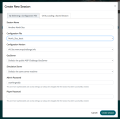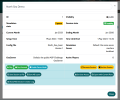|
|
| Line 21: |
Line 21: |
| </gallery> | | </gallery> |
|
| |
|
| ==Managing MSP Challenge server session == | | ==Managing MSP Challenge server sessions == |
| | <gallery mode="slideshow"> |
| | File:Server Manager quick actions.png|Once a session has been created, you can manipulate it in different ways. The Quick Action buttons on the right give you the options to play and pause the simulations, save the session in its current state, or view more session details (the i - icon). |
| | File:Server Manager session details.png|If you click on the i - icon to get the session details, a new window opens up, showing you the current state of the session, and providing you with more options. You also have access to the session creation log from here. |
| | File:Server Manager play pause fast-forward demo.png|In the session details window, you'll see the play and pause buttons as well. You'll also see a button to fast-forward the simulations through the current era. There's also a button to enable demo mode. If you click, you'll get a message first explaining what that does, which you can then cancel or confirm. |
| | File:Server Manager session recreate and archive.png|You'll also see recreate and archive session buttons. The former will recreate the session using the originally specified configuration file, GeoServer, passwords, etc. If you do this, everything that already happened on the server will be lost. The latter just archives the session, making it unavailable to end-users. Again, everything that already happened on the server will be lost. |
| | File:Server Manager save options.png|With the save buttons you can either save the session in its current state as a ZIP file (which you'll be able to download and optionally reload again as another session), or just save all the data layers as ShapeFiles (including any plans end-users made to change them) and raster files into one ZIP file (which you'll just be able to download). |
| | File:Server Manager export plans and set user access.png|These two options are more advanced options, explained separately below. |
| | </gallery> |
| | |
| | == Advanced MSP Challenge Server Manager options == |
Revision as of 08:51, 1 May 2024
On this page you will learn how to:
- Set up your own MSP Challenge server sessions after installing the full platform
- Managing your own MSP Challenge server session using the Server Manager application
Setting up a new MSP Challenge server session
To create a new server session - or to put it in other terms - to create a new instance of for example the North Sea, open your Server Manager web application (for more information, see the full platform installation manual), and from there, here's what you do next:
When you open the Server Manager for the first time, you might be asked to log in first with your MSP Challenge account. Afterwards, you should see this notice. Read it carefully, and click through using the provided link.
You will now see an empty sessions list, which makes sense as this is a fresh installation. Click on the New Session button under the Sessions tab to get started.
Fill in the form. At least enter a name, select the configuration of choice, and enter an administrator password. When you're ready, click on the Create Session button.
The session creation process should now start. You will get a confirmation message, and a new window in the bottom-right corner will pop up showing the progress. Please be patient.
At some point, the new session's state should change from 'request' to 'setup'. The progress window in the bottom-right corner should indicate that the session creation process finished. The session can now be accessed through the MSP Challenge client.
Are you using your own GeoServer?
If you want to use your own GeoServer installation, then add it before setting up a new server session:
Back in your Server Manager, click on the Settings tab, and then click on the Change button in the GeoServers column.
To add your new GeoServer, fill in the form. Be sure to enter a fully-qualified base URL to your GeoServer. Enter a username and password with which MSP Challenge can access GeoServer to retrieve/get layer data (no additional privileges required). When you're ready, click on Add.
The GeoServers window will close again. If you now click on Change again, the window re-opens and should show the additional GeoServer in the list at the top. If you want to use your new GeoServer as the default when creating new sessions, click on the eye icon next to the top 'Default: the public MSP Challenge GeoServer' entry to make it invisible.
If you go back to the Sessions tab, and click on New Session button, you'll notice that your additional GeoServer has become available under the GeoServer dropdown list. If you made the Default BUas GeoServer invisible, it won't even show up here at all.
Managing MSP Challenge server sessions
Once a session has been created, you can manipulate it in different ways. The Quick Action buttons on the right give you the options to play and pause the simulations, save the session in its current state, or view more session details (the i - icon).
If you click on the i - icon to get the session details, a new window opens up, showing you the current state of the session, and providing you with more options. You also have access to the session creation log from here.
In the session details window, you'll see the play and pause buttons as well. You'll also see a button to fast-forward the simulations through the current era. There's also a button to enable demo mode. If you click, you'll get a message first explaining what that does, which you can then cancel or confirm.
You'll also see recreate and archive session buttons. The former will recreate the session using the originally specified configuration file, GeoServer, passwords, etc. If you do this, everything that already happened on the server will be lost. The latter just archives the session, making it unavailable to end-users. Again, everything that already happened on the server will be lost.
With the save buttons you can either save the session in its current state as a ZIP file (which you'll be able to download and optionally reload again as another session), or just save all the data layers as ShapeFiles (including any plans end-users made to change them) and raster files into one ZIP file (which you'll just be able to download).
These two options are more advanced options, explained separately below.
Advanced MSP Challenge Server Manager options










 Co-funded by the European Union.
Co-funded by the European Union.